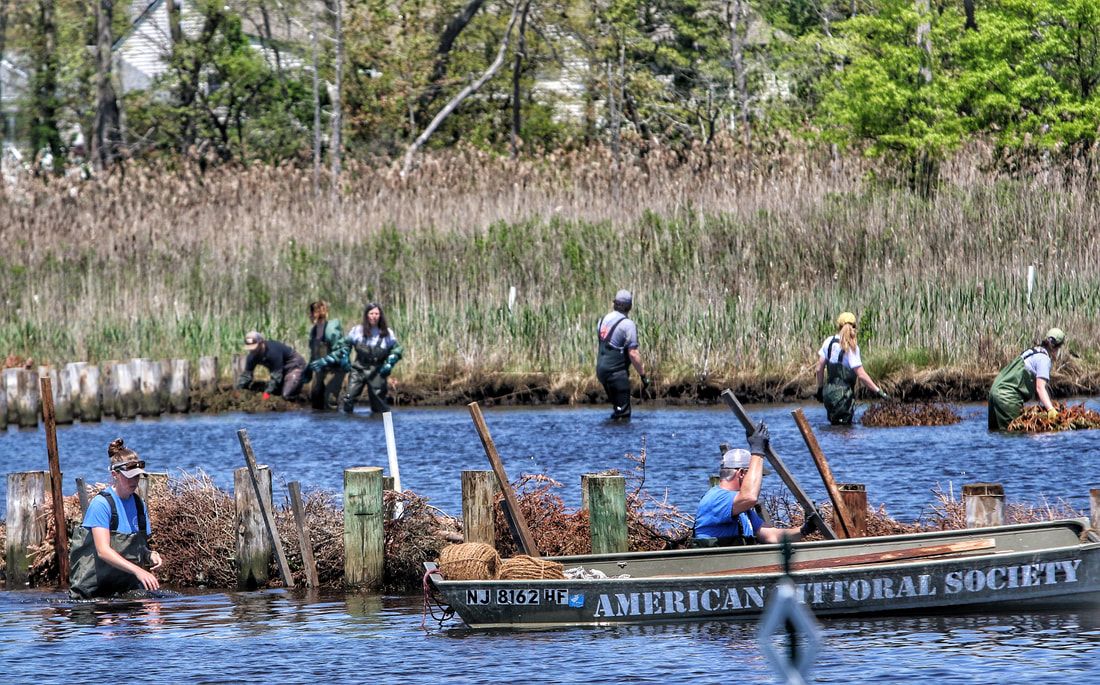|
It was Christmas in May, as a bevy of volunteers did their bit to help begin restoration of an eroded shoreline at Slade Dale Sanctuary in Point Pleasant, NJ. Now it's Mother Nature's turn to play her role in the process, under the watchful eye of the American Littoral Society. A first-of-its-kind project for New Jersey, the restoration work involves using recycled Christmas trees placed in branchbox breakwaters and tree vanes to re-establish the shoreline of a salt marsh along Beaverdam Creek. The wetlands have eroded approximately 300 feet over the past century. "You could smell Christmas in the air," said Capt. Al Modjeski, Habitat Restoration Director for the American Littoral Society, recalling the May 11 workday. "But placing the trees only sets the stage for the next phases of this project." Rather than use heavy equipment to fill in the receded area -- which could further damage the delicate marsh -- the project uses a carefully planned series of breakwaters, stuffed with about 500 recycled Christmas trees, to blunt storm surge, slow the currents moving through the eroded area, and use natural tidal forces to recapture sand from the creek. "This is a great opportunity to show how living shorelines can provide a low-cost, natural solution to a long-term problem," Modjeski said. Sometimes referred to as nature-based, green, or soft shorelines, living shorelines use natural materials such as plants, sand or rock to stabilize the shoreline, reduce erosion, and provide valuable habitat. They also tend to be far less expensive to construct and maintain that hard structures. Living shorelines are an alternative to hardened shoreline structures such a bulkheads and seawalls. Unlike hard structures, which impede the growth of plants and animals, living shorelines grow over time. “This project is a model for other living shoreline efforts, puts our sustainable principles into action, and reflects wonderful partnerships with the town, US Fish and Wildlife Service and the Corporate Wetlands Partnership,” said Tim Dillingham, Executive Director of the American Littoral Society. Slade Dale Sanctuary is a 13-acre preserve situated along the North Branch of Beaverdam Creek, a tidal tributary that flows into the larger Metedeconk River and, eventually, Barnegat Bay. The Sanctuary’s pine-oak forest, hardwood swamp, and salt marsh provide a space of protected wilderness in an otherwise heavily developed coastal area of NJ. The salt marsh at Slade Dale helps protect uplands from flooding during storms. It also provides nursery habitat for fish, as well as foraging habitat for birds such as osprey, egrets, and bald eagles. Unfortunately, Slade Dale Sanctuary is disappearing. In addition to the erosion, the current vegetation composition of the site shows evidence of marsh retreat. Dead or dying tree species suggest these locations were previously upland and have since become inundated as the shoreline eroded. "The sanctuary has been losing ground for years," said Zack Royle, American Littoral Society Habitat Restoration Technician. "What our work will do is not only stop the loss, but help nature build it back into something that is both protective and beautiful." With nature now at work rebuilding the eroded area, Littoral Society staff will transfer attention to creating a citizen science brigade to help with monitoring the project. Monitoring will focus on measuring the buildup of sediment, movement of the shoreline, changes in vegetation, the integrity of the breakwater pilings, and whether additional trees need to be added. There will also be time lapse photography of the site to create a visual representation of how the area changes. While Littoral Society staff will visit the site monthly, volunteer citizen scientists will be recruited to help with monitoring. Additional Christmas tree drives will be conducted as needed to help fill in where initial trees are naturally deteriorating. "Given that this restoration technique has not been used previously in New Jersey, attention will need to be paid," Modjeski said. "However, we are now looking to use the same restoration techniques up creek at Sunshine Cove." Project partners include: New Jersey Corporate Wetlands Partnership, Borough of Point Pleasant, The Nature Conservancy, Point Pleasant Rotary Club, and Princeton Hydro. Comments are closed.
|
Archives
July 2024
Categories
All
|


